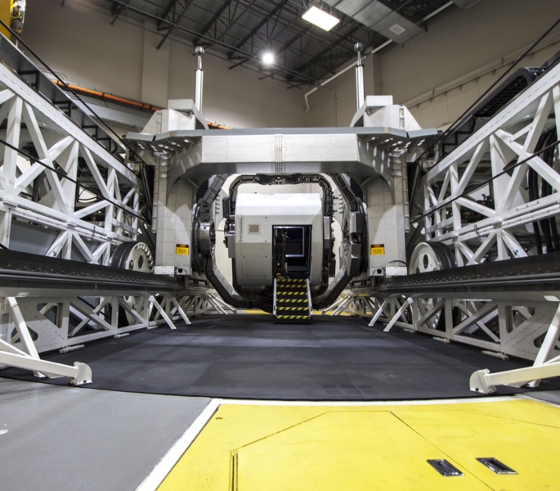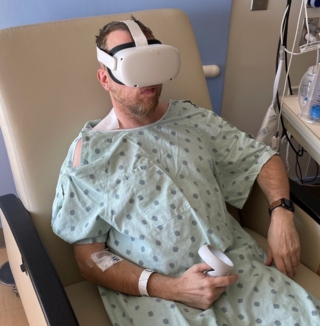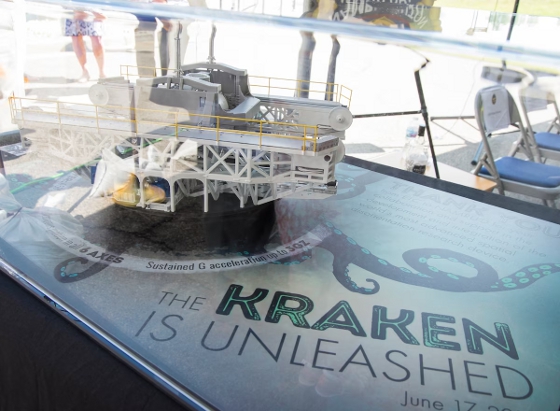 |
| June 06, 2023 | Volume 19 Issue 21 |
Designfax weekly eMagazine
Archives
Partners
Manufacturing Center
Product Spotlight
Modern Applications News
Metalworking Ideas For
Today's Job Shops
Tooling and Production
Strategies for large
metalworking plants
Unleash the Kraken: NASA using U.S. Navy spinning device to simulate spaceflight

A view of the entrance to the cockpit of the Kraken, a device that can be configured to disorient those strapped inside. The parallel tracks on the left and right allow the cockpit to lurch forward and backward while it independently spins. [Credit: U.S. Navy]
By Nathan Cranford and Jennifer Turner, NASA Human Research Program Strategic Communications
A monster of a machine is now allowing NASA scientists to study on Earth the disorientation that astronauts may encounter in space.
This machine is the U.S. Navy's Kraken, a device that can vigorously spin occupants like laundry churning in a washing machine. A new collaboration with the Navy will allow NASA scientists to use the Kraken to build strategies that aim to ease motion sickness. Such strategies may not only help astronauts but could also offer treatment options for patients with balance issues here on Earth.
Astronauts may experience motion sickness on their launch into space and on their return to Earth. Symptoms include dizziness, nausea, and vertigo -- a feeling of spinning -- which can make it difficult to carry out mission-critical tasks when landing or exiting spacecraft.
"Shortly after liftoff in the space shuttle, I felt like I was on a merry-go-round as my body hunted for what was up, down, left, and right," said NASA astronaut Douglas Wheelock. "Crew must prepare for the confusion that they will likely undergo during these gravitational transitions."
Enter the Kraken, a 50-ft-long, 100-ton platform at Wright-Patterson Air Force Base near Dayton, Ohio. It can be configured to replicate different types of flight to disorient occupants through sudden shifts in roll, pitch, and yaw, superimposed onto horizontal and vertical lurches. A spaceflight setting on the Kraken will allow NASA scientists to study whether a specific technology, coupled with head movements, may help soothe the motion sickness experienced by some astronauts.
VIDEO: The Kraken isn't only a mystical creature from the deep. At the Naval Medical Research Unit Dayton at Wright-Patterson Air Force Base, the U.S. Navy is using its own Kraken -- the GL-6000 Disorientation Research Device -- not to destroy but to save lives. See how this monster machine is working to protect American aviators.
"The first time I saw the Kraken in person, I was impressed by how large and agile the machine is," said Laura Bollweg, who manages astronaut health research at NASA's Johnson Space Center in Houston. "With the ability to move six directions on its axis, the device can simulate complex flight scenarios that are difficult to recreate on Earth, including landing scenarios that could induce vertigo and nausea."
In an upcoming study, NASA and Navy scientists will recruit 24 active-duty service members to ride in the Kraken for 60 minutes. The Kraken will then spin them at accelerations reaching three times the force of gravity to simulate what astronauts experience when they first return to Earth.
Upon exiting the machine, 12 volunteers will perform prescribed head turns and tilts while wearing video goggles that track their head and eye movements. The technology will capture measurements associated with motion sickness, including how much participants blink as well as changes to heart rate. The volunteers will also respond to real-time questions about how disorientated and sick they feel.
The remaining Kraken riders will not perform any head movement protocols. All volunteers will then complete four tasks -- they'll test their balance standing on foam with eyes open and closed, their speed on a nearly 33-ft (10-m) walk, their endurance on a two-minute walk, and the length of time they take to finish a standing and walking test that includes stepping over an obstacle. Normally, these tasks would be easy, but after the ride, dizziness and poor balance may make them take longer.

A patient experiencing balance issues wears video goggles for measuring head and eye movements. The dial he's holding allows him to rate his levels of motion sickness as he tests out different head motions. A similar setup will be used on riders just after they exit the Kraken. [Credit: Johns Hopkins University]
"Anecdotes from astronauts suggest that performing slight head movements helps them recover a sense of balance more quickly," said study lead Michael Schubert, a neurophysiologist at Johns Hopkins University in Baltimore, Maryland. "Tests with the Kraken will allow us to rigorously determine what head movements, if any, help astronauts to quickly recover their sense of balance."
If verified, astronauts could adopt specific protocols to help them quickly adapt to gravitational changes during spaceflight, including on longer and more distant missions, said Schubert.
As part of a two-pronged strategy, Schubert's team also aims to see if the head motions can help patients with balance issues. Apart from riding in the Kraken, 24 civilian patients will attempt to complete the same four tasks performed by service members. Half will perform the same set of head motions beforehand, and the other half won't.
These patients have had tumors removed from their inner ears, a process which includes cutting a nerve central to maintaining balance. As a result, the patients often endure dizzy spells and vertigo. "Confirming that the head movements help patients in this study may allow NASA and the Navy to play a vital role in bringing a new set of therapies to the public," said Schubert.
"This study renews a partnership between our laboratory and NASA, tracing back to the space program through the 1960s and 1970s," said Richard Arnold, director of the Naval Aerospace Medical Research Laboratory in Dayton, the organization that operates the Kraken. "We are excited to build on previous collaborations by addressing motion issues faced by both Naval aviators and NASA astronauts."
---------------
SIDEBAR: More about the Navy's Kraken device
The Naval Medical Research Unit Dayton christened its $19 million GL-6000 Disorientation Research Device known as the Kraken at the Captain Ashton Graybiel Acceleration Research Facility on June 17, 2016. The device was designed and built by Environmental Tectonics Corporation.
At that time, Navy Capt. Rees Lee, NMRU-D commanding officer, described the Kraken device as "245,000 pounds, 4,500 horsepower, simultaneous motion on six axis, sustained planetary motion of 3G, and horizontal travel to 16-and-a-half feet" and said it "allows researchers to create the most realistic motion simulations never before imagined."

A model of the disorientation research device nicknamed the Kraken is displayed at the dedication ceremony for the Captain Ashton Graybiel Acceleration Research Facility at Naval Medical Research Unit Dayton, June 17, 2016, at Wright-Patterson Air Force Base, Ohio. Kraken allows researchers to create the most realistic motion simulations ever seen, using all six degrees of freedom and up to 3 Gs of force. [Credit: U.S. Air Force photo/R.J. Oriez]
Graybiel's research team, based at Naval Air Station Pensacola, Florida, developed state-of-the-art acceleration research devices and procedures, completing landmark studies on the effects of weightlessness and acceleration on human balance, spatial orientation, physiology, and performance. His team's research provided the vital physiology knowledge so important to the success of the Mercury, Gemini, and Apollo space programs, Lee said.
Lee said that one Air Force report estimated that motion-related mishaps have cost the Air Force $2 billion in lost aircraft. "But more important are the lost lives. It is my firm conviction that together with our Air Force and Army aeromedical research colleagues, the research findings coming from this facility will save lives," he said, adding, "For the first time in the history of aerospace medicine, fully realistic motion simulations can be created which allow the exhaustive research necessary for a comprehensive understanding of spatial disorientation and other motion and acceleration-based phenomenon."
Source: U.S. Navy
---------------
Published June 2023
Rate this article
View our terms of use and privacy policy
